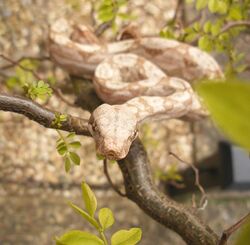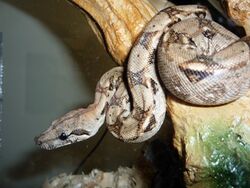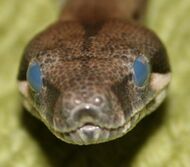Biology:Boa imperator
| Boa imperator | |
|---|---|
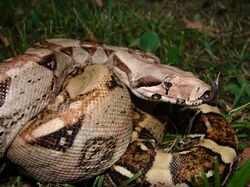
| |
| Scientific classification | |
| Domain: | Eukaryota |
| Kingdom: | Animalia |
| Phylum: | Chordata |
| Class: | Reptilia |
| Order: | Squamata |
| Suborder: | Serpentes |
| Family: | Boidae |
| Genus: | Boa |
| Species: | B. imperator
|
| Binomial name | |
| Boa imperator Daudin, 1803
| |
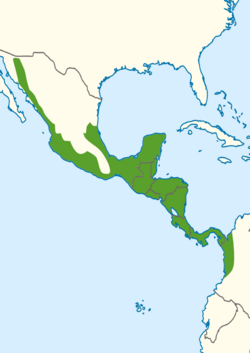
| |
| Distribution range for Boa imperator | |
| Synonyms[2] | |
| |
Boa imperator is a large, heavy-bodied, nonvenomous species[3] of snake, of the boa genus, that is commonly kept in captivity. Boa imperator is part of the family Boidae and is found in Mexico, Central America and South America west of the Andes Mountains (primarily Colombia).[4] It is commonly called the northern boa, Colombian boa and common northern boa and is frequently and erroneously referred to as the red-tailed boa or Colombian red-tailed boa, especially in the pet trade.
Description
Boa imperator is wide-ranging, with animals living in both Central America and northern parts of South America.[5] As a result, the appearance of this snake varies greatly depending on the specific locality. As one of the smaller Boa species,[6] they average between 1.3 and 2.5 m in length when fully grown, but have been known to reach 3.7 m.[7] They usually weigh around 6 kg (13 lb), although females are significantly larger than males. Lifespan in the wild is around 20–30 years, but 40 can be exceeded in captivity.[6]
Although Boa imperator exhibits almost identical patterns to Boa constrictor, this species often has a darker tail, usually dark brown or very dark red. They are, however, usually just as colorful as their counterparts and, like the larger boas, can be bred into a variety of different colors, given the right conditions to breed.
Notably, the species is one of only two in snakes to have a confirmed XY sex chromosome system, as revealed in a groundbreaking study in 2017. [8]
One population is found on the Cayos Cochinos (Hog Islands) off the northern shore of Honduras. These are naturally hypomelanistic, which means that they have reduced melanin, thus are more lightly colored, although they retain the distinctive darker tail that is characteristic of most members of this species. The color of the tail may vary from salmon-pink to orange.[9]
Another well known population of Boa imperator is the population from Nicaragua. While not as small as the dwarf insular island populations, adults are still smaller than the larger B. c. constrictor. The size of a mature female Nicaraguan boa is 1.1 m and 1.9 kg, while the larger female B. c. constrictor is not mature until she reaches 1.6 m and 4.5 kg.[10] Nicaraguan individuals typically have a compact saddle pattern on their backs that is often circular in shape.[11] These boas have a reputation for being "nippy", with some individuals being quick to bite in self-defense.[citation needed]
Mainland specimens from Colombia can be among the larger boas, but this subspecies also includes a number of dwarf insular populations, such as those from various Caribbean islands and the Sonoran Desert of Mexico. These populations represent the smallest members of the species.
Scalation
Boa imperator has 55-79 dorsal scales, 225-253 ventral scales, 47-69 subcaudal scales, 18-22 supralabial scales and 1-2 anal scales. [12]
Identification
Boa imperator is commonly confused with other Boa species, such as Boa constrictor.
Taxonomy
Boa imperator was formerly classified as a subspecies of Boa constrictor until DNA sequencing identified B. c. imperator as a separate genetic lineage with 5-7% divergence from B. constrictor. Widespread acceptance is still pending, but several publications have acknowledged the new name since this finding.[13]
Certain Boa populations, such as Hog Island, Corn Island, Tarahumara, Ecuador, etc.[13] are currently classified as different 'locales' of Boa imperator. These locales have yet to be reclassified as official sub-species.[14]
Geographic range
Boa imperator can be found in some regions of Mexico, Central America and northwestern Colombia, as well as several islands along the coasts of these areas. The type locality given is "l'Amerique meridionale, principalement au Mexique" (Central America, principally Mexico).[2]
Boa imperator can acclimatize to a variety of environmental conditions, from tropical rainforests to arid deserts; however, it prefers to live in rainforests due to humidity, temperature, cover from potential predators and ample prey.
Behavior
Boa imperator generally live on their own, and do not interact with any other snakes unless they want to mate. They are crepuscular, but they may bask during the day when night-time temperatures are too low. As semi-arboreal snakes, young Boa imperator may climb into trees and shrubs to forage; however, they become mostly terrestrial as they become older and heavier.[15] Boa imperators strike when they perceive a threat. Their bite can be painful, especially from large snakes, but is rarely dangerous to humans. Specimens from Central America are more irascible, hissing loudly and striking repeatedly when disturbed, while those from South America tame down more readily.[16] Like all snakes, Boa imperators in a shed cycle are more unpredictable, because the substance that lubricates between the old skin and the new makes their eyes appear milky, blue or opaque, so that the snake cannot see very well, causing it to be more defensive than it might be otherwise.
Hunting and diet
Boa imperator, like most Boa species, has a varied diet that consists mainly of rodents, birds, lizards and frogs. [17] The size of the prey item increases as it ages.
Boa imperator, like other Boa species, are nocturnal ambush predators. They use constriction as the primary means of incapacitating their prey. [17]
Captivity
Boa imperator is one of the most common snakes kept in captivity; this is mainly due to their calm dispositions, impressive size potential and variety of color and pattern choices. Captive common boas often tolerate being handled for extended periods.[18] Captive Boa imperator are generally fed pre-killed mice in an attempt to reduce damage to the specimen from the prey.[18]
This snake species has been a common species in the global pet trade since the 1980s, with 115,131 individuals being exported between 1989 and 2000. [19] Wild caught specimens will often contain parasites, both internal and external. The most common parasite is Ophionyssus natricis or the "reptile mite".
Boa imperator captive breeders will often breed for a specific color or "morph". There are several color and pattern morphs available in the pet trade, such as albino, hypomelanistic, motley and jungle individuals.[18]
References
- ↑ Montgomery, C.E. & da Cunha, O. 2018. Boa imperator. The IUCN Red List of Threatened Species 2018: e.T203879A2771951. https://doi.org/10.2305/IUCN.UK.2018-2.RLTS.T203879A2771951.en. Downloaded on 05 February 2019.
- ↑ 2.0 2.1 McDiarmid RW, Campbell JA, Touré T. 1999. Snake Species of the World: A Taxonomic and Geographic Reference, vol. 1. Herpetologists' League. 511 pp. ISBN:1-893777-00-6 (series). ISBN:1-893777-01-4 (volume).
- ↑ "Boa constrictor imperator". Integrated Taxonomic Information System. https://www.itis.gov/servlet/SingleRpt/SingleRpt?search_topic=TSN&search_value=635078. Retrieved 7 July 2008.
- ↑ Boa imperator at the Reptarium.cz Reptile Database
- ↑ "Archived copy". Archived from the original on 2011-07-15. https://web.archive.org/web/20110715173844/http://www.reptileguru.com/care-red%20tail%20boas.aspx. Retrieved 2011-03-03.
- ↑ 6.0 6.1 Cotswold Wildlife Park and Gardens
- ↑ "Common Boa Constrictor - Boa constrictor imperator". Exotic-pets.co.uk. http://www.exotic-pets.co.uk/common-boa.html. Retrieved 2013-04-18.
- ↑ Gamble, T., Castoe, T. A., Nielsen, S. V., Banks, J. L., Card, D. C., Schield, D. R., Schuett, G. W. & Booth, W. (2017) The Discovery of XY Sex Chromosomes in a Boa and Python. Current Biology. 27 (14), 2148-2153.e4. Available from: doi: 10.1016/j.cub.2017.06.010.
- ↑ "Hog Island Boa Care Sheet". https://www.reptilerange.com/hog-island-boa-care-sheet/. Retrieved 8 April 2020.
- ↑ "Boa Care". Rio Bravo Reptiles. http://www.riobravoreptiles.com/care_raisingboas.htm. Retrieved 2013-04-18.
- ↑ "theboas.com". theboas.com. http://www.theboas.com/eng/index.php?obs=imperator&nab=boa_nab. Retrieved 2013-04-18.
- ↑ Lotte, Jose; Lotte, Ben (1996). "Taxonomy and Description of Boa Constrictor". Litteratura Serpentium 16 (#3): 78–81. http://www.snakesociety.nl/jaargangen/1996e/Litteratura%20Serpentium%2016-3%20078-081%20Lotte%20and%20Lotte,%20Taxonomy%20and%20determination%20of%20Boa%20constrictor.pdf. Retrieved 2018-10-22.
- ↑ 13.0 13.1 Healey, Mariah (2018). "Boa Species & Subspecies" (in en-US). https://reptifiles.com/boa-constrictor-care/boa-species-subspecies/.
- ↑ "Hog Island Boa Care". https://www.reptilerange.com/hog-island-boa-care-sheet/. Retrieved 6 May 2020.
- ↑ Mehrtens JM. 1987. Living Snakes of the World in Color. New York: Sterling Publishers. ISBN:0-8069-6460-X.
- ↑ Stidworthy J. 1974. Snakes of the World. Grosset & Dunlap Inc. ISBN:0-448-11856-4.
- ↑ 17.0 17.1 BOBACK, S. M. 2005. Natural history and conservation of island boas (Boa constrictor) in Belize. Copeia 2005: 879–884
- ↑ 18.0 18.1 18.2 Reptiles Magazine Boa Care sheet
- ↑ Global Invasive Species Database (GISD) 2015. Species profile Boa constrictor imperator. Available from: http://www.iucngisd.org/gisd/species.php?sc=1439 [Accessed 23 October 2018]
External links
- Boa imperator at the Reptarium.cz Reptile Database. Accessed 7 July 2018.
Wikidata ☰ Q58741252 entry

